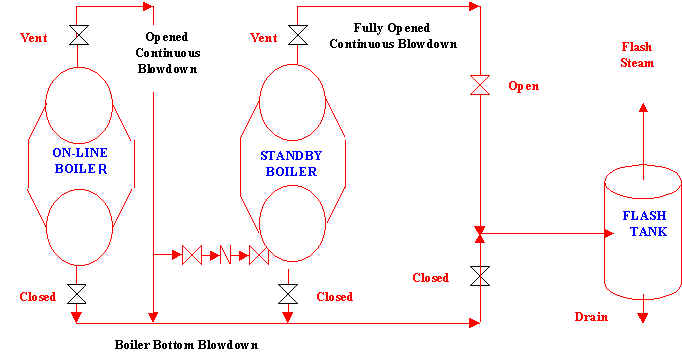BOILER STORAGE PROCEDURES
Many facilities have excess boiler capacity in the form of standby units. Choosing the best way to properly protect the equipment from oxygen pitting and/or general corrosion can be quite a challenge. The most commonly known and utilized methods are (1) wet storage and (2) dry storage. There is also a third less known method available (3) hot/wet storage. Before discussing the different alternatives, the status of the standby equipment must be classified by the need for future operation:
Equipment which will not be required to operate at a moments notice. An example of this may be a facility that has an extra "Standby" unit not required for its operation and a facility that may be closed and it's boiler(s) idled for an indefinite period of time.
Equipment that may be needed at a moments notice. For instance, the operating unit has a flame failure and after several unsuccessful attempts to restart the boiler it becomes clear you have a major problem. As the system steam pressure continues to drop the need for "Emergency Standby" occurs.
Now that we have classified the equipment it is time to discuss the different options available:
DRY STORAGE: This method is preferred whenever a boiler is in standby allowing time to prepare the unit for operation. Be sure the unit is completely drained and dry. If possible, heaters should be used to maintain the temperature of all surfaces above the dew point. Then a desiccant should be applied to either watertight wood or corrosion resistant trays as follows:
Quick Lime-at six pounds per 100 cubic ft. volume OR
Silica Gel @ eight pounds per 100 cubic feet of volume OR
Use Cortec VCI boiler lay-up treatment.
With another boiler operating in the boiler room, to assure low humidity in the air, the trays should be placed in each drum of a watertube boiler or on the top tubes of a firetube boiler. The feedwater inlet and steam outlet should be checked to ensure no dampness occurs in the boiler from these points. All manhole and hand-hole covers should remain opened to allow dry air to enter the unit. Be sure to inspect the boiler internals every month to ensure against any moisture. When the desiccant becomes hard due to absorbing moisture, be sure to promptly replace it.
WET STORAGE: This method is most commonly used whenever a boiler is in "Standby", allowing time to prepare the unit for operation. The boiler should be filled to its normal level using deaerated feedwater whenever possible. Add three pounds of caustic soda and one and one half pounds of sodium sulfite per 1000 gallons of water capacity. Then open boiler vents, apply heat for one to two hours, and allow the unit to cool for an hour after firing. Then completely fill the unit with deaerated feedwater. All boiler vents and drains should now be closed and the drain between the non-return and the main steam stop valve should be left fully opened. The boiler water should be tested periodically and additional chemical added as needed to maintain sulfite at a minimum of 100 ppm and p-alkalinity at a minimum of 400 ppm.
HOT WET STORAGE: This method uses hot treated blowdown from an operating boiler to keep an "Emergency Standby" unit protected and ready to operate at a moments notice. It is accomplished by connecting the continuous blowdown line from the operating unit to a bottom blowdown location of the standby unit. With all vents closed on the standby unit and the continuous blowdown line opened, the hot treated water from the operating boiler continuous blowdown will pass into the bottom of the standby unit and out the continuous blowdown line to the blowdown flash tank.


